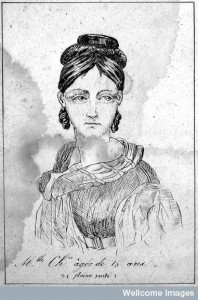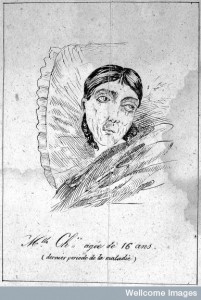By Lisa Smith, W&M Contributor

Before masturbation. Mlle Chxx aged 15 years (1836). Credit: Wellcome Library, London.
Remember all those playground stories about masturbation causing hairy palms and blindness? Those tales go way back. During the eighteenth and nineteenth centuries, much ink was spilled on the devastation that masturbation would cause. Men’s frequent self-pleasuring would destroy the fibres of their penis, and the masturbator would become effeminate, weak, infertile and leaky. The female masturbator, however, was discussed less often. But for a woman, there were two greater dangers: that she might lose control of her body and that her husband might lose control of her.
The anonymous author of The Ladies Dispensatory (1739) recounted two cautionary tales of masturbating women. One young woman abused herself between the ages of 14 and 19, resulting in a furor uterinus (nymphomania). During increasingly violent fits, the woman undressed and violently attacked any man nearby. She soon after died, at which point doctors and surgeons anatomized her. They found that her clitoris had swollen abnormally and that her blood appeared especially sharp and corrosive. In the other story, a young woman discovered masturbation at the age of eleven with her mother’s chambermaid. Seven years later, she had developed a clitoris so large that she appeared to be a hermaphrodite. The doctors attributed this to clitoral relaxation. Through masturbation, both young women became ‘masculine’ and sexually aggressive, with uncontrollable bodies.
Taken to its logical conclusion, the body of a female masturbator might even create its own offspring, independent of human action. Physician G. A. Douglas argued in his book, The Nature and Causes of Impotence in Men, and Barrenness in Women (1758), that false conceptions could be caused by self-abuse. He suggested that women needed vaginal stimulation in order to make an egg descend. If a woman used “those shameful implements” to stimulate herself, she would produce an egg that would remain unfertilised and grow so that it resembled a pregnancy. Women, he warned, “should know this and tremble”. Given the loss of bodily control, it is no wonder that female masturbation was seen as dangerous. Masturbation resulted in inverted social and sexual hierarchies: men became womanly and women became manly.
However, this was not the only reason why the secret vice of women “strikes at the very root of fertility.” Most importantly, according to The Ladies Dispensatory, a wife who masturbated might be beyond her husband’s will. The fear was that barrenness would result from a woman’s “Indifferency to the Pleasures of Venus, and in Time a Total Ineptitude to the Act of Generation itself.” For example, one young lady wrote a letter to the anonymous author of Onania (1716) that she had learned masturbation at boarding school. She married at seventeen and produced three children within two years. Then her husband died and, for two more years, she eased her desires and comforted her loneliness through excessive masturbation. She became concerned three years into her second marriage when she had failed to produce any children. The physical symptoms included weakness, a bearing down of the womb and a pain in the back. Worst of all, though, she was not interested in “the Act of Procreation.” She complained that she had “very little or no Pleasure in the Act, which I am thinking may be as much as anything, the Reason I can have no children.”
The author of The Ladies Dispensatory included the case of a young woman who had been married for four years, from the age of seventeen. She masturbated regularly from the age of eleven and continued after marriage, even in preference to her husband. Her womb was so slippery that her periods had stopped and she had not yet become pregnant. The authors of Onania and The Ladies Dispensatory sympathised with the plight of the husband: “How must it grieve them [the women] when they find the ends of it [marriage] unanswered, and have room to charge their ineptitude to Procreation on their own fault? Both Husband and Wife perhaps may be passionately desirous of Issue, and the good man may think it a Defect in himself.” Through her lack of self-control, the masturbating woman brought disorder to the marital relationship. The husband, unaware of his wife’s activities, blamed himself for the failure to conceive and was unable to keep her sexuality under his control.
Overgrown clitorises? False pregnancies? Sterility? Failed marriages? The twentieth-century playground fears about masturbation had nothing on the eighteenth-century ones!
Lisa Smith is an Associate Professor of History at the University of Saskatchewan. She writes on gender, family, and health care in England and France (ca. 1600-1800). She also blogs weekly on history of medicine and science at her Sloane Letters Blog and edits The Recipes Project. She tweets as @historybeagle.

